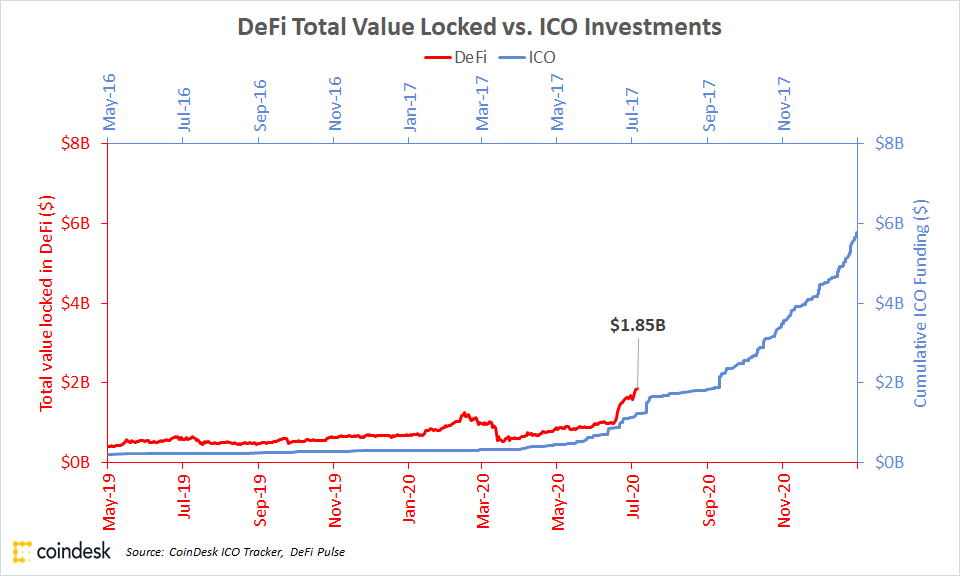It’s effectively July 2017 in the world of decentralized finance (DeFi), and as in the heady days of the initial coin offering (ICO) boom, the numb
It’s effectively July 2017 in the world of decentralized finance (DeFi), and as in the heady days of the initial coin offering (ICO) boom, the numbers are only trending up.
According to DeFi Pulse, there is $1.9 billion in crypto assets locked in DeFi right now. According to the CoinDesk ICO Tracker, the ICO market started chugging past $1 billion in July 2017, just a few months before token sales started getting talked about on TV.
Debate juxtaposing these numbers if you like, but what no one can question is this: Crypto users are putting more and more value to work in DeFi applications, driven largely by the introduction of a whole new yield-generating pasture, Compound’s COMP governance token.
Governance tokens enable users to vote on the future of decentralized protocols, sure, but they also present fresh ways for DeFi founders to entice assets onto their platforms.
That said, it’s the crypto liquidity providers who are the stars of the present moment. They even have a meme-worthy name: yield farmers.

Where it started
Ethereum-based credit market Compound started distributing its governance token, COMP, to the protocol’s users this past June 15. Demand for the token (heightened by the way its automatic distribution was structured) kicked off the present craze and moved Compound into the leading position in DeFi.
The hot new term in crypto is “yield farming,” a shorthand for clever strategies where putting crypto temporarily at the disposal of some startup’s application earns its owner more cryptocurrency.
Another term floating about is “liquidity mining.”
The buzz around these concepts has evolved into a low rumble as more and more people get interested.
The casual crypto observer who only pops into the market when activity heats up might be starting to get faint vibes that something is happening right now. Take our word for it: Yield farming is the source of those vibes.
But if all these terms (“DeFi,” “liquidity mining,” “yield farming”) are so much Greek to you, fear not. We’re here to catch you up. We’ll get into all of them.
We’re going to go from very basic to more advanced, so feel free to skip ahead.
What are tokens?
Most CoinDesk readers probably know this, but just in case: Tokens are like the money video-game players earn while fighting monsters, money they can use to buy gear or weapons in the universe of their favorite game.
But with blockchains, tokens aren’t limited to only one massively multiplayer online money game. They can be earned in one and used in lots of others. They usually represent either ownership in something (like a piece of a Uniswap liquidity pool, which we will get into later) or access to some service. For example, in the Brave browser, ads can only be bought using basic attention token (BAT).
If tokens are worth money, then you can bank with them or at least do things that look very much like banking. Thus: decentralized finance.
Tokens proved to be the big use case for Ethereum, the second-biggest blockchain in the world. The term of art here is “ERC-20 tokens,” which refers to a software standard that allows token creators to write rules for them. Tokens can be used a few ways. Often, they are used as a form of money within a set of applications. So the idea for Kin was to create a token that web users could spend with each other at such tiny amounts that it would almost feel like they weren’t spending anything; that is, money for the internet.
Governance tokens are different. They are not like a token at a video-game arcade, as so many tokens were described in the past. They work more like certificates to serve in an ever-changing legislature in that they give holders the right to vote on changes to a protocol.
So on the platform that proved DeFi could fly, MakerDAO, holders of its governance token, MKR, vote almost every week on small changes to parameters that govern how much it costs to borrow and how much savers earn, and so on.
Read more: Why DeFi’s Billion-Dollar Milestone Matters
One thing all crypto tokens have in common, though, is they are tradable and they have a price. So, if tokens are worth money, then you can bank with them or at least do things that look very much like banking. Thus: decentralized finance.
What is DeFi?
Fair question. For folks who tuned out for a bit in 2018, we used to call this “open finance.” That construction seems to have faded, though, and “DeFi” is the new lingo.
In case that doesn’t jog your memory, DeFi is all the things that let you play with money, and the only identification you need is a crypto wallet.
On the normal web, you can’t buy a blender without giving the site owner enough data to learn your whole life history. In DeFi, you can borrow money without anyone even asking for your name.
I can explain this but nothing really brings it home like trying one of these applications. If you have an Ethereum wallet that has even $20 worth of crypto…
www.coindesk.com
